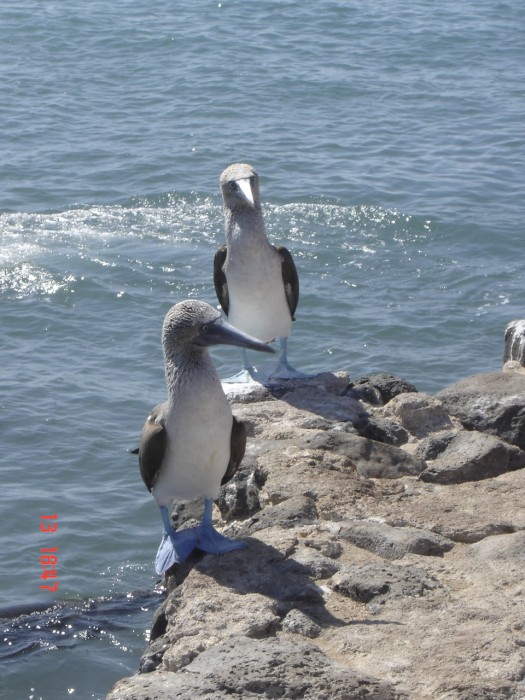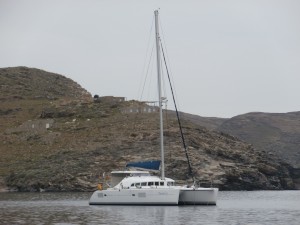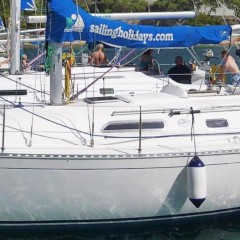
Panormitis happenings
24 May 2016 | Rodds Bay
24 December 2015
06 November 2015 | Bustard bay
04 November 2015 | Port Bundaberg Marina
27 October 2015 | Port Bundaberg
17 October 2015 | Mele Maat
04 October 2015 | Village of Mele
27 September 2015 | Port Vila
27 September 2015 | Mololo LaiLai
10 September 2015 | Vuda Marina
02 September 2015 | Lautoka
31 August 2015 | Lautoka Fiji
24 August 2015 | Nieafu Tonga
24 August 2015 | Aloft Niue
24 August 2015 | Beveridge Reef
24 August 2015 | Palmerston Island
24 August 2015 | Maupihaa
23 August 2015 | Raiatea
22 August 2015 | Moorea
21 August 2015 | Baie D'Opunohu
The Galapagos
05 June 2015 | Wreck Bay San Cristobel

Greetings from French Polynesia
Back to the Galapagos first. A little information about them just in case you are interested. They are a group of volcanic islands on the equator about 600 miles from the coast of Ecuador. There are 13 main islands and are known for their tame and unique wildlife, living amidst barren volcanic scenery. The islands are one of the 20 provinces of Ecuador and the authorities take their custody of the wildlife sanctuary seriously. The islands were found by accident in the early 16th century when a ship carrying the Bishop of Panama drifted off course. Originally named Islas Encantadas – the Enchanted Islands- they were the base for pirates, sealers and whalers. Famous sailors such as Drake, Raleigh and Cook stopped for refuge and provisions. The main provision was the giant tortoises which could be kept alive for months on end, giving a fresh source of meat. Thousands were taken and killed. The Spanish name for the tortoises is Galapagos which in Spanish means saddle which is the shape of the shells of these giants. Hence the renaming and the reason. Of course the most famous visitor was Charles Darwin in 1835 and he stayed 5 weeks. His observations of how the wildlife developed into unique species by adjusting to their environment were central to his theory of evolution. The population has grown quickly. San Cristobal Island had a population of 600 just 15 years ago. It is now over 6000. The official language is Spanish. I reckon that Spanish should be the second language in the world, ‘cos we’ve encountered it more than any other in our travels. Water is poor quality so they rely on desalination. Most things are brought in by ship and they don’t have a jetty so barges load and unload their cargo and ferry it to and from the shore. They have their fair share of tourist cruisers too which have to anchor out and use their tenders to take their passengers ashore for sightseeing.
There are a couple of Charles Darwin Research Stations on different islands Their main focus is scientific research. On San Cristobal they have the breeding centre for the tortoises which were threatened. The first breeding trial was in 1995 and they had only one survivor so they called him Genesis. They currently have a 70% success rate but it takes ages for them to grow. It isn’t til they are 13 years old that their sex can be determined.
Now that you know all that I’ll continue with our story in the next blog.
Back to the Galapagos first. A little information about them just in case you are interested. They are a group of volcanic islands on the equator about 600 miles from the coast of Ecuador. There are 13 main islands and are known for their tame and unique wildlife, living amidst barren volcanic scenery. The islands are one of the 20 provinces of Ecuador and the authorities take their custody of the wildlife sanctuary seriously. The islands were found by accident in the early 16th century when a ship carrying the Bishop of Panama drifted off course. Originally named Islas Encantadas – the Enchanted Islands- they were the base for pirates, sealers and whalers. Famous sailors such as Drake, Raleigh and Cook stopped for refuge and provisions. The main provision was the giant tortoises which could be kept alive for months on end, giving a fresh source of meat. Thousands were taken and killed. The Spanish name for the tortoises is Galapagos which in Spanish means saddle which is the shape of the shells of these giants. Hence the renaming and the reason. Of course the most famous visitor was Charles Darwin in 1835 and he stayed 5 weeks. His observations of how the wildlife developed into unique species by adjusting to their environment were central to his theory of evolution. The population has grown quickly. San Cristobal Island had a population of 600 just 15 years ago. It is now over 6000. The official language is Spanish. I reckon that Spanish should be the second language in the world, ‘cos we’ve encountered it more than any other in our travels. Water is poor quality so they rely on desalination. Most things are brought in by ship and they don’t have a jetty so barges load and unload their cargo and ferry it to and from the shore. They have their fair share of tourist cruisers too which have to anchor out and use their tenders to take their passengers ashore for sightseeing.
There are a couple of Charles Darwin Research Stations on different islands Their main focus is scientific research. On San Cristobal they have the breeding centre for the tortoises which were threatened. The first breeding trial was in 1995 and they had only one survivor so they called him Genesis. They currently have a 70% success rate but it takes ages for them to grow. It isn’t til they are 13 years old that their sex can be determined.
Now that you know all that I’ll continue with our story in the next blog.
Comments
| Vessel Name: | Panormitis |
| Vessel Make/Model: | Lagoon 410S2 |
| Hailing Port: | Gladstone Australia |
| Crew: | Gary and Del Whitmore |
| About: | Gary has salt water in his veins and needs to be near or on the water. Del is his wife and his sailing partner. |
| Extra: | We learned to sail together back in 1977 and have enjoyed a variety of yachts since then. We have previously purchased a monohull in Croatia and took 18months to sail it back to Australia. Now we are doing the trip again this time with a catamaran. |
| Home Page: | http://www.sailblogs.com/member/panormitis |
| Social: |
Gallery not available
Panormitis @ anchor

Who: Gary and Del Whitmore
Port: Gladstone Australia


